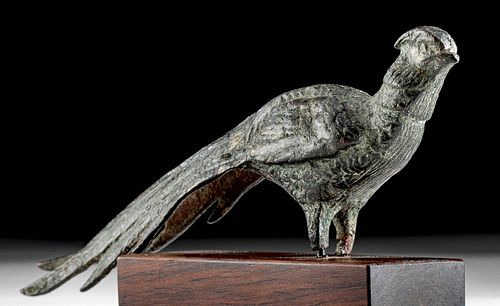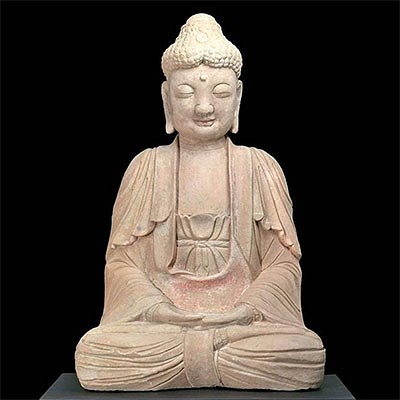Exhibited 5th C. Byzantine Brass Pheasant
Lot 66b
About Seller
Artemis Gallery
686 S Taylor Ave, Ste 106
Louisville, CO 80027
United States
Selling antiquities, ancient and ethnographic art online since 1993, Artemis Gallery specializes in Classical Antiquities (Egyptian, Greek, Roman, Near Eastern), Asian, Pre-Columbian, African / Tribal / Oceanographic art. Our extensive inventory includes pottery, stone, metal, wood, glass and textil...Read more
Categories
Estimate:
$8,000 - $12,000
Absentee vs Live bid
Two ways to bid:
- Leave a max absentee bid and the platform will bid on your behalf up to your maximum bid during the live auction.
- Bid live during the auction and your bids will be submitted real-time to the auctioneer.
Bid Increments
| Price | Bid Increment |
|---|---|
| $0 | $25 |
| $300 | $50 |
| $1,000 | $100 |
| $2,000 | $250 |
| $5,000 | $500 |
| $10,000 | $1,000 |
| $20,000 | $2,500 |
| $50,000 | $5,000 |
| $100,000 | $10,000 |
| $200,000 | $20,000 |
About Auction
By Artemis Gallery
Feb 18, 2021
Set Reminder
2021-02-18 10:00:00
2021-02-18 10:00:00
America/New_York
Bidsquare
Bidsquare : Exceptional Antiquities, Asian, Ethnographic
https://www.bidsquare.com/auctions/artemis-gallery/exceptional-antiquities-asian-ethnographic-6373
Museum-worthy examples of Egyptian, Greek, Roman, Etruscan, Near Eastern, Far East / Asian, Pre-Columbian, African / Tribal, Oceanic, Native American, Spanish Colonial, Russian, Fossils, Ancient Jewelry, Fine Art, so much more! Artemis Gallery info@artemisgallery.com
Museum-worthy examples of Egyptian, Greek, Roman, Etruscan, Near Eastern, Far East / Asian, Pre-Columbian, African / Tribal, Oceanic, Native American, Spanish Colonial, Russian, Fossils, Ancient Jewelry, Fine Art, so much more! Artemis Gallery info@artemisgallery.com
- Lot Description
Near East, Byzantine, ca. 5th century CE. A charming brass pheasant, finely cast via the lost wax (cire perdue) technique, with a pert head and crest, standing upright upon its feet - its wings folded back, its graceful tailfeathers fanned out behind, and rendered with plumage presenting a mesmerizing delineation of feathering. The pheasant was an important bird in the ancient world, and Byzantines bred them not only for the table but also to be admired for their beauty. During an excavation of 2005, for example, archaeologists discovered that the 6th century so-called "Bird Mosaic" adorned the atrium of a large Byzantine palace outside the city wall of Byzantine Caesarea. Although the mosaic includes many different types of animals - bull, ibex, elephant, dog, and bear - the mosaic also includes 120 medallions that each contain a bird, hence it was named the "Bird Mosaic". Eleven different species are depicted, including flamingo, duck, peacock, partridge, guineafowl, ibis, goose, pelican, as well as pheasant. Size: 4.625" L x 0.75" W x 1.875" H (11.7 cm x 1.9 cm x 4.8 cm); 2.5" H (6.4 cm) on included custom stand.
Published: J. Eisenberg, Art of the Ancient World, vol. IV (1985), no. 318.
On loan to Miami University Art Museum; Ball State University Art Gallery; George Mason University; Fitchburg Art Museum from 1988 to 2016.
Provenance: ex-P.F. collection, Richmond, Michigan, USA, acquired from Royal Athena in February, 1988
All items legal to buy/sell under U.S. Statute covering cultural patrimony Code 2600, CHAPTER 14, and are guaranteed to be as described or your money back.
A Certificate of Authenticity will accompany all winning bids.
We ship worldwide and handle all shipping in-house for your convenience.
#160098Missing feet. Collection label on bottom of stand. Expected light softening of detail. Otherwise, excellent with lovely rich patina.Condition
- Shipping Info
-
All shipping is handled in-house for your convenience. Your invoice from Artemis Gallery will include shipping calculation instructions. If in doubt, please inquire BEFORE bidding for estimated shipping costs for individual items.
-
- Buyer's Premium



 EUR
EUR CAD
CAD AUD
AUD GBP
GBP MXN
MXN HKD
HKD CNY
CNY MYR
MYR SEK
SEK SGD
SGD CHF
CHF THB
THB














